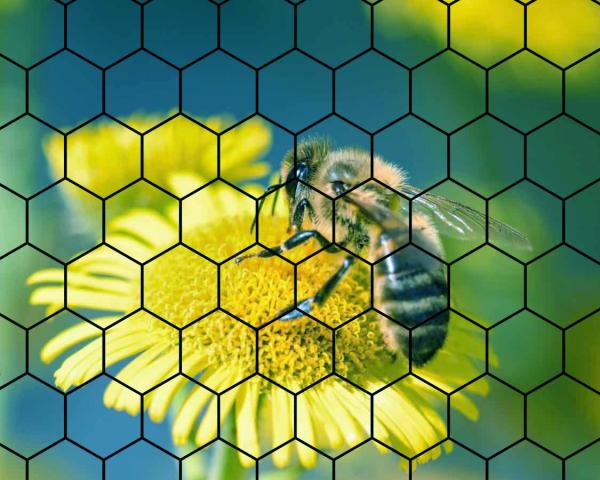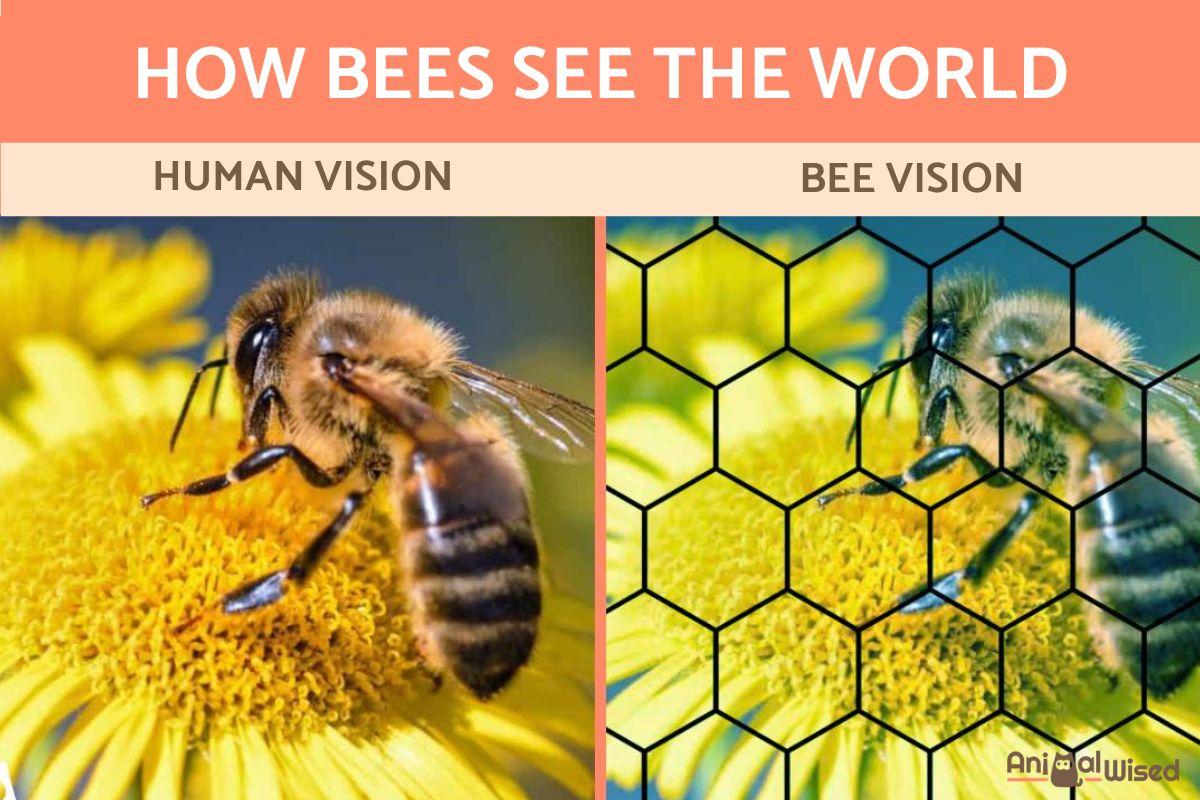How Do Bees See?


Bees, the tireless pollinators of our planet, possess a remarkable visual system that is crucial for their survival and success. Bees play a pivotal role in maintaining healthy ecosystems and ensuring food security for humans. Their ability to pollinate a wide variety of plants, from crops to wildflowers, is critical for both agricultural production and natural biodiversity. Bee vision is fundamental to this process, enabling them to identify and distinguish between different flower species, even at a distance.
The following AnimalWised article explores bee's vision, their main characteristics, how it's different from our own vision, and much more.
How are the eyes of bees?
To grasp the intricacies of bee vision, it's crucial to understand the structure of their eyes.
All bee species possess compound eyes, comprised of numerous hexagonal units known as ommatidia. The number of ommatidia per eye can range from 1,000 to 16,000, depending on the bee's species and, in the case of social bees, its caste. These tiny ommatidia function as individual visual components, each responsible for collecting light from a specific portion of the bee's surroundings.
Within each ommatidium, specialized structures called photoreceptors play a vital role. These elongated, aligned cells contain pigments responsible for light absorption. As light interacts with these pigments, they undergo a structural change, initiating a series of processes that transform light into an electrical signal. This signal then travels to the bee's brain, where it is interpreted and consolidated into a singular binocular image.
How many eyes do bees have?
Honey bees have five eyes: two compound eyes and three simple eyes, also known as ocelli. The compound eyes are located on the sides of the head and are responsible for most of the bee's vision. Each compound eye is made up of thousands of tiny lenses called ommatidia. These ommatidia work together to create a mosaic-like image of the world. The three ocelli are located in a triangle on the top of the head and are responsible for detecting light and helping the bee to navigate.

How good is bee vision?
Bee vision is quite remarkable, enabling them to navigate their complex environment effectively and locate food sources with precision.
Bees also possess an extraordinary ability to see ultraviolet (UV) light, which is invisible to humans. This unique vision plays a crucial role in their pollination activities, as many flowers have UV markings that guide bees to nectar and pollen.
Not only that but bees are highly sensitive to motion, allowing them to detect and track moving objects, such as predators or potential mates.
Finally, bees can also detect the polarization of light, which is the direction of its electric field. This ability is thought to help them navigate using the sun's position, even on cloudy days.
Bees can also learn to associate certain visual cues with rewarding flower sources. This ability helps them to remember which flowers to visit in the future, increasing their foraging efficiency.
How does a bee's vision compare with human vision?
Bee vision is very different from human vision, each tailored to their unique ecological niches and lifestyle requirements. Both bees and humans have compound eyes, but bees have thousands of tiny lenses called ommatidia, while humans have a single lens and retina.
On one hand, bees are trichromatic, perceiving three primary colors like humans, but they also see ultraviolet (UV) light, which is invisible to humans. Bees also have a much wider field of view than humans. This allows them to see more of their surroundings at once, which is helpful for spotting flowers from a distance.
On the other hand, bees have lower visual acuity than humans but can distinguish between flower shapes, colors, and patterns.
Can bee see colors?
Bees are indeed capable of perceiving colors, but their color vision differs significantly from that of humans.
Humans possess trichromatic vision, enabling them to perceive three primary colors: red, green, and blue. Bees, on the other hand, also exhibit trichromatic vision but are sensitive to a different portion of the color spectrum.
Bees have the unique ability to perceive ultraviolet (UV) light, which lies beyond the range of human vision. Flowers often bear UV patterns that are invisible to humans but readily visible to bees. These UV patterns serve as visual guides for bees, assisting them in locating nectar and pollen within flowers.
In addition to UV, bees are also sensitive to blue and green colors. However, they have difficulty distinguishing between red and black, as these colors appear quite similar to them. This enhanced ability to perceive a broader spectrum of colors, including ultraviolet, is essential for bees in their foraging activities and in recognizing and selecting flowers for pollination.
Beyond their impressive vision, bees possess a sophisticated communication system that allows them to navigate, forage, and even reproduce. Learn more about it in this other article.

What colors are bees attracted to?
Bees are attracted to a variety of colors, and their preferences can vary depending on the species and the availability of flowers in their environment. However, some general trends have been observed.
Bees are drawn to flowers that are blue, purple, or violet in color. These flowers are extra visible to bees because they reflect ultraviolet (UV) light. Humans can't see UV light, but bees can, and they use it to find flowers.
Bees also like flowers that are yellow, white, or pink. These colors are also thought to be easy for bees to see, and they may be attracted to them because they look like nectar, which is food that bees need to survive.
What colors are bees not attracted to?
Bees are less attracted to red flowers. This is likely because red light is not as well reflected by flowers, and bees may have difficulty seeing red flowers.
It is important to note that, in addition to color, bees are also attracted to the scent of flowers. Different flowers have different scents, and bees learn to associate certain scents with good sources of nectar and pollen. While bees are renowned for their pollination prowess, their stinger serves as a crucial tool for protection and survival.
Do bees see at night?
Bees are primarily diurnal creatures, meaning they are active during the day and rest at night. Unlike some nocturnal insects, bees do not have adaptations for seeing in low-light conditions. Their compound eyes, which are well-suited for daylight vision, are not as effective in low light.
Typically, bees are not active at night, and they return to their hives or nests to rest. However, some exceptions exist. For example, there are certain species of bees, such as the tropical stingless bees (Meliponini), that may exhibit limited nocturnal activity. Even in these cases, their night vision is not as developed as that of true nocturnal insects.
From the nectar they collect to the pollen they consume, bees carefully curate their diet to ensure their health and vitality. Learn more about what bees eat in this other article.
If you want to read similar articles to How Do Bees See?, we recommend you visit our Facts about the animal kingdom category.
- Chittka, L., & Wells, H. (2004). Color vision in bees: mechanisms, ecology and evolution . Complex worlds from simpler nervous systems, 165-191.
- Seidl, R., & Kaiser, W. (1981). Visual field size, binocular domain and the ommatidial array of the compound eyes in worker honey bees . Journal of comparative physiology, 143(1), 17-26.
- Srinivasan, M. V. (2010). Honey bees as a model for vision, perception, and cognition . Annual review of entomology, 55, 267-284.
- Warrant, E. J. (2008). Seeing in the dark: vision and visual behavior in nocturnal bees and wasps . Journal of Experimental Biology, 211(11), 1737-1746.
- Zeil, J., Ribi, W.A., & Narendra, A. (2014). Polarization vision in ants, bees and wasps . In Polarized light and polarization vision in animal sciences (pp. 41-60). Springer, Berlin, Heidelberg.







